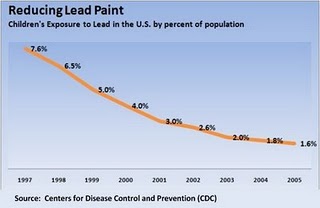US Children’s Blood Lead Levels are Declining
BLOOD LEAD LEVELS DECLINING, BUT CHILDREN STILL AT RISK FOR LEAD POISONING
As a residential re-modeler one of my concerns when working on a home is the presence of lead paint. The good news is that in the US Children’s blood lead levels are declining.
Lead Dust And The body
An April 2003 issue of the New England Journal of Medicine concluded that lead levels even below the 10 micrograms can be harmful, especially in children. The researchers wrote, “Our findings suggest that considerably more U.S. children are adversely affected by environmental lead [lead on bridges, water tanks and structures] than previously estimated.” Read How Lead affects the body.
Trends in Blood Lead Levels
Children’s blood lead levels continue to decrease in the United States, but some children continue to be at greater risk for http://www.aconcordcarpenter.com/rrp-lead-paint-rule-consideration.html than others. In the study, “Trends in Blood Lead Levels and Blood Lead Testing Among US Children Aged 1 to 5 Years, 1988-2004,” results indicate an 84 percent decline of elevated blood lead levels among children from 1988 to 2004.
However, the major risk factors for higher blood lead levels continue to be living in housing built before 1950, poverty, age and being non-Hispanic black.
Because children can be exposed to lead from multiple sources, including consumer products and imported toys, health care providers must continue to test children at high risk for lead poisoning, and to identify and control all lead sources that can poison children.
As contractors performing residential remodeling projects we need to be aware of lead in homes and how to control lead exposure and lead dust.
Having a good dust control strategy is a start as is following the U.S. Environmental Protection Agency (EPA) issued Renovation, Repair and Painting (RRP) Rule requirements.
Source: American Academy of Pediatrics





